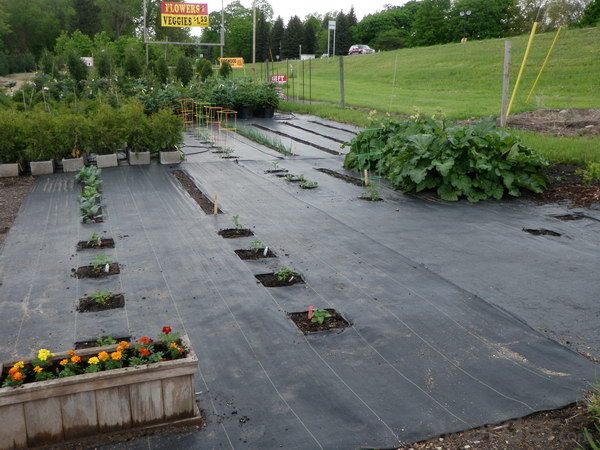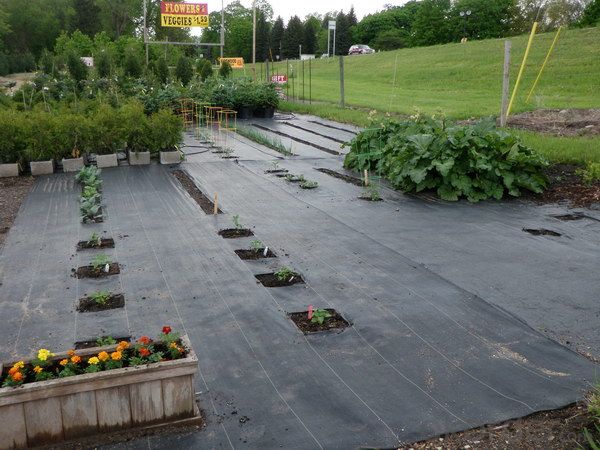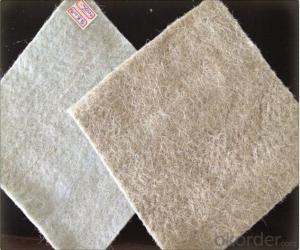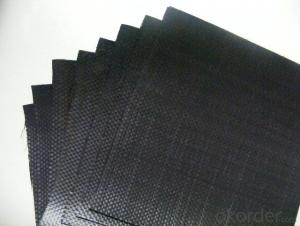Geotextile 3D Honeycomb Weed Barrier Fabric/Polypropylene Fabric with Black Color
- Loading Port:
- China main port
- Payment Terms:
- TT OR LC
- Min Order Qty:
- 5000 roll
- Supply Capability:
- 100000 roll/month
OKorder Service Pledge
OKorder Financial Service
You Might Also Like
1. Landscape Fabric Description:
Landscape Fabric is made of environmentally friendly raw materials, pp spunbond nonwoven fabric. It used to prevent the growth of weed, without the use of potentially dangerous chemical sprays or labor intensive hoeing. Once installed, weed mat will continue providing protection for years without maintenance.



2. Landscape Fabric Feature:
1. Weed suppressant and drainage control landscaping fabric
2. Spun bonded non-woven fabric – will not fray when cut
3. Easy to use
4. Environmentally friendly
5. Allows water, air and nutrients through, suppressing weeds without the use of chemicals
6. Good alternative to Plantex® where cost is a factor
7. UV Stabilised
8. Reduces the level of watering required due to the slower rate of water evaporation
3. Landscape Fabric Function:
1. Cover crops in the ground surface,prevent weeds and against the insect
2. Controlling soil humidity and the temperature
3. Does not affect the growth of the crops
4. Protects plants from harmfully solar radiation
5. Air permeability, water permeability help crops growth.
6. Mothproof, eco-friendly, breathable, anti-bacteria, tear-resistant, fusible


4. FAQ:
Q1: What is your minimum order quantity?
A:The minimum order quantity is 5000 ,but it is negotiable.
Q2:What is your payment terms?
A: T/T,Western Union,Paypal,L/C...
Q3:What is your delivery time?
A:Production time usually costs 2-20 days.
Waiting to cooperate with you!
- Q: How do geotextiles help in preventing the growth of weeds?
- Geotextiles help in preventing the growth of weeds by acting as a physical barrier between the soil and the environment. These synthetic fabrics are placed over the soil, suppressing weed growth by blocking sunlight, which weeds need for photosynthesis. Geotextiles also inhibit weed root penetration, preventing them from establishing a strong foothold in the soil. Additionally, the fabric allows water and nutrients to pass through, promoting healthy plant growth while suppressing weed development.
- Q: How do geotextiles help in preventing soil erosion on slopes?
- Geotextiles act as a barrier between soil and water, allowing for better drainage and filtration. They stabilize the soil, prevent particle movement, and reduce surface erosion by increasing the overall shear strength of the slope.
- Q: How do geotextiles improve the performance of drainage systems?
- Geotextiles improve the performance of drainage systems by providing filtration and separation, preventing the clogging of soil particles and allowing water to flow freely. They also enhance the stability and strength of the system, acting as a reinforcement layer to distribute loads and prevent soil erosion. Additionally, geotextiles can help control the migration of fine particles, increasing the longevity and efficiency of the drainage system.
- Q: What are the key considerations for geotextile installation in cold climates?
- Some key considerations for geotextile installation in cold climates include selecting a geotextile material that is designed for cold weather conditions, ensuring proper site preparation and ground stabilization, protecting the geotextile from frost heave or ice damage, and taking into account the potential for snow accumulation and removal on the geotextile surface. Additionally, considering the impact of freeze-thaw cycles and designing proper drainage systems are crucial for successful geotextile installation in cold climates.
- Q: What are the factors to consider when selecting a geotextile?
- When selecting a geotextile, there are several factors to consider. Firstly, the application or purpose of the geotextile is important. Different geotextiles are designed for specific functions such as filtration, separation, drainage, or reinforcement. Understanding the specific requirements of the project and matching them with the appropriate geotextile is crucial. Secondly, the site conditions need to be evaluated. Factors such as soil type, slope stability, groundwater levels, and expected loads or stresses should be considered. The geotextile should be able to withstand these conditions and provide the necessary performance. Thirdly, the durability and longevity of the geotextile should be assessed. Factors like UV resistance, resistance to chemicals or biological degradation, and the expected lifespan should be evaluated to ensure that the selected geotextile can withstand the anticipated environmental conditions. Additionally, the installation and maintenance requirements should be taken into account. Some geotextiles may require specialized equipment or techniques for installation, while others may need periodic monitoring or maintenance. Understanding these requirements is essential for a successful project. Lastly, cost-effectiveness is an important factor. While it is crucial to select a geotextile that meets the project requirements, it is also necessary to consider the associated costs. Evaluating the initial cost, as well as the long-term benefits and potential savings, helps in making an informed decision. In summary, the factors to consider when selecting a geotextile include the specific application, site conditions, durability, installation requirements, and cost-effectiveness.
- Q: What are the specifications for geotextiles in erosion control projects?
- The specifications for geotextiles in erosion control projects typically include factors such as the material type, strength and durability, permeability, and installation requirements. It is important for geotextiles used in erosion control to be made of high-quality materials that can withstand environmental conditions and provide effective soil stabilization. The strength and durability of geotextiles should be capable of withstanding the forces exerted by flowing water and soil particles. Additionally, the permeability of geotextiles should allow for proper water drainage while preventing soil erosion. Proper installation techniques, such as overlap and anchoring, are also important specifications to ensure the geotextiles effectively control erosion.
- Q: How do geotextiles help with soil confinement in erosion control block walls?
- Geotextiles play a crucial role in soil confinement within erosion control block walls by acting as a filter and separator. They prevent soil particles from washing out while allowing water to drain through, thereby reducing hydrostatic pressure and the risk of wall failure. Additionally, geotextiles enhance the overall stability and longevity of the wall by providing reinforcement and preventing soil erosion.
- Q: How are geotextiles used in coastal engineering?
- Geotextiles are commonly used in coastal engineering to stabilize and protect coastlines. They are placed beneath coastal structures or along the shoreline to prevent erosion, reduce wave impact, and enhance sedimentation. Geotextiles act as a barrier, preventing the loss of soil while allowing water to pass through, thereby minimizing the negative effects of waves and tides on the coastline. Additionally, they provide a stable foundation for coastal structures like revetments, breakwaters, and seawalls, helping to maintain their integrity and longevity.
- Q: Precautions for Polyester Filament Geotextiles
- 1. Geotextiles can only be cut with a geotextile (hook knife), such as in the field of cutting, other materials to take special protective measures to prevent the cutting of geotextiles and its unnecessary damage; Laying geotextile at the same time, must take all necessary measures to prevent damage to the following layer of material; 3. In the laying of geotextiles, we must pay attention not to let the stone, a lot of dust or moisture may damage the geotextile, Drains or filters, or materials that may cause difficulties for subsequent connections to enter beneath geotextiles or geotextiles; 4. After installation, visualize all geotextile surfaces to identify all damaged landlords Marking and repairing, to determine the laying of the surface can not cause damage to foreign substances, such as broken needle and other foreign body; 5. Geotextile connection must follow the following provisions: Under normal circumstances, the slope can not have a horizontal connection (connection along the slope The contours do not intersect with them), except where the patch is located. 6. If the use of suture, suture should be used with geotextile material the same or more than the material, suture should be anti-chemical UV material holding. Suture and geotextile should have a significant color difference in order to facilitate inspection. 7. Special attention to suturing during installation to ensure that no gravel in the soil or gravel cover is in the middle of the geotextile.
- Q: Geotextile with glue can stick cement wall
- There is a special geomembrane ks glue, I am specializing in the production of geotechnical materials
Send your message to us
Geotextile 3D Honeycomb Weed Barrier Fabric/Polypropylene Fabric with Black Color
- Loading Port:
- China main port
- Payment Terms:
- TT OR LC
- Min Order Qty:
- 5000 roll
- Supply Capability:
- 100000 roll/month
OKorder Service Pledge
OKorder Financial Service
Similar products
Hot products
Hot Searches
Related keywords
































